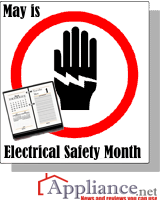CPSC Warns of Dangerous Counterfeit Electrical Products
 WASHINGTON, D.C. — May is National Electrical Safety Month, and the U.S. Consumer Product Safety Commission (CPSC) is warning consumers that, unlike a fake purse or watch, counterfeit electrical products could pose the risk of injury or death. Counterfeit circuit breakers, power strips, extension cords, batteries and holiday lights can cause fires, explosions, shocks and electrocutions.
WASHINGTON, D.C. — May is National Electrical Safety Month, and the U.S. Consumer Product Safety Commission (CPSC) is warning consumers that, unlike a fake purse or watch, counterfeit electrical products could pose the risk of injury or death. Counterfeit circuit breakers, power strips, extension cords, batteries and holiday lights can cause fires, explosions, shocks and electrocutions.
Often, manufacturers of counterfeit products neglect to use key components or skimp in the manufacturing process in order to save money.
While cheaper prices are passed onto consumers, so too are the dangers.
Fake consumer products are not tested for compliance to relevant safety standards.
CPSC has recalled more than one million counterfeit electrical products in recent years, including circuit breakers that did not trip when overloaded; cell phone batteries without a safety device in the circuitry to prevent overcharging; and extension cords with mislabeled, undersized wiring that overheated.
“We are very concerned about unsafe electrical products,” said Acting Chairman Nancy Nord. “Our priority is to keep consumers safe by preventing potentially dangerous counterfeit products from getting into the marketplace in the first place.”
Many counterfeit products are made in China and CPSC is actively working with the Chinese government to reduce the number of unsafe products that are exported to the United States. CPSC has also been working with Customs and Border Protection in the Department of Homeland Security, legitimate manufacturers, and certifying testing laboratories to identify and stop unsafe counterfeit products at U.S. ports and in the marketplace.
Counterfeits can be extremely difficult to spot. A counterfeit electrical product could be a knock-off of a name brand product or one that bears an unauthorized certification marking. CPSC offers the following tips to help avoid counterfeit hazards:
- Scrutinize the product, the packaging and the labeling. Look for a certification mark from an independent testing organization, such as Underwriters Laboratories (UL), and the manufacturer’s label.
- Trademarked logos that look different than usual may signal a counterfeit.
- Trust your instincts. If the price is “too good to be true,” it could be because the product is an inferior and unsafe counterfeit.
- Be extra vigilant when buying from an unknown source such as a street vendor, non-authorized dealer, dollar store, online retailer or an individual. Ask about the return policy. Get a receipt and look for missing sales tax. Businesses selling counterfeit goods often don’t report their sales.
- Stay informed. Sign up for CPSC e-mail alerts, so when a dangerous product is recalled, you’ll know about it right away.
- Report safety-related incidents to the manufacturer or CPSC.
For additional electrical safety information about counterfeit products, visit the Electrical Safety Foundation International’s Web site
To report a dangerous product or a product-related injury, call CPSC’s hotline at (800) 638-2772.